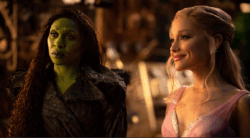Through the innocent eyes of a child, the horrifying injustices of the Holocaust amass a certain naive surrelity. In The Boy in the Striped Pajamas, director Mark Herman uses this perspective, similar to that of Anne Frank, to evoke the full impact and emotion of this tragedy. Based upon the novel by Irish author John Boyne, the film follows in the tradition of many Holocaust movies, like Schindler’s List, in both content and quality.

Set in World War II Germany, the film follows a young boy named Bruno and his family, who live under the rule of Hitler’s Third Reich in Berlin. When his father receives a promotion—to become the head of a death camp, as he later discovers—Bruno and his family move to the austere countryside, where their cold, modern house mimes the barbed wire fence of the adjacent camp. Always the explorer, Bruno ventures to “the farm” as the prison is called, where he meets Shmuel, who he finds curiously dressed in “striped pajamas.” From this first encounter blossoms a relationship through which the movie explores themes of innocence, adventure, and the very act of bearing witness to the deeper iniquities of the Holocaust.
Soft piano compositions and acute sound effects magnify the emotion of the film’s disturbing realities. All of the film’s actors effectively portray the complexity of the situation in which they live. Bruno’s father accepts his duty as a loyal soldier, while his sister swallows the Hitler youth Nazi propaganda. Bruno observes the Jews around him and cannot accept the prejudiced lies forced upon him.
Telling the story through Bruno’s perspective provides the key element to the film, which opens with a quote from British poet John Betjeman: “Childhood is measured out by sounds and smells and sights, before the dark hour of reason grows.” Herman captures the sounds and sights of Bruno’s experience, from running through the forest to observing the smoke of human ash in the sky to the skull badges he sees on his father’s uniform. The rich colors and freedom of the forest contrast sharply with the washed out, fenced-in camp, just as Bruno’s character provides a foil to Shmuel.
Herman juxtaposes Bruno’s normal life with that of Smuel to highlight the monstrosity of the Holocaust, never relying on more obvious illustrative devices such as blood or wanton violence. From Bruno’s perspective, the beating and murder of the Jewish worker in their house by a Nazi soldier is not a righteous act. It is an act perpetrated by a condescending man against someone who helped Bruno on several occasions and who is, above all, a human being.
His simple questions—such as, Why does Shmuel wear pajamas?—sharply reveal the injustice and corruption present in the young boy’s surroundings.
As Herman maintains, “You’re never too young to learn about the idiocy of racism and the folly of prejudice.” Neither are you ever too old to be reminded of the awful capabilities of the human race. Boy in the Striped Pajamas reminds us all of the value of humanity with a story that is as heart-breaking as it is horrifying.




